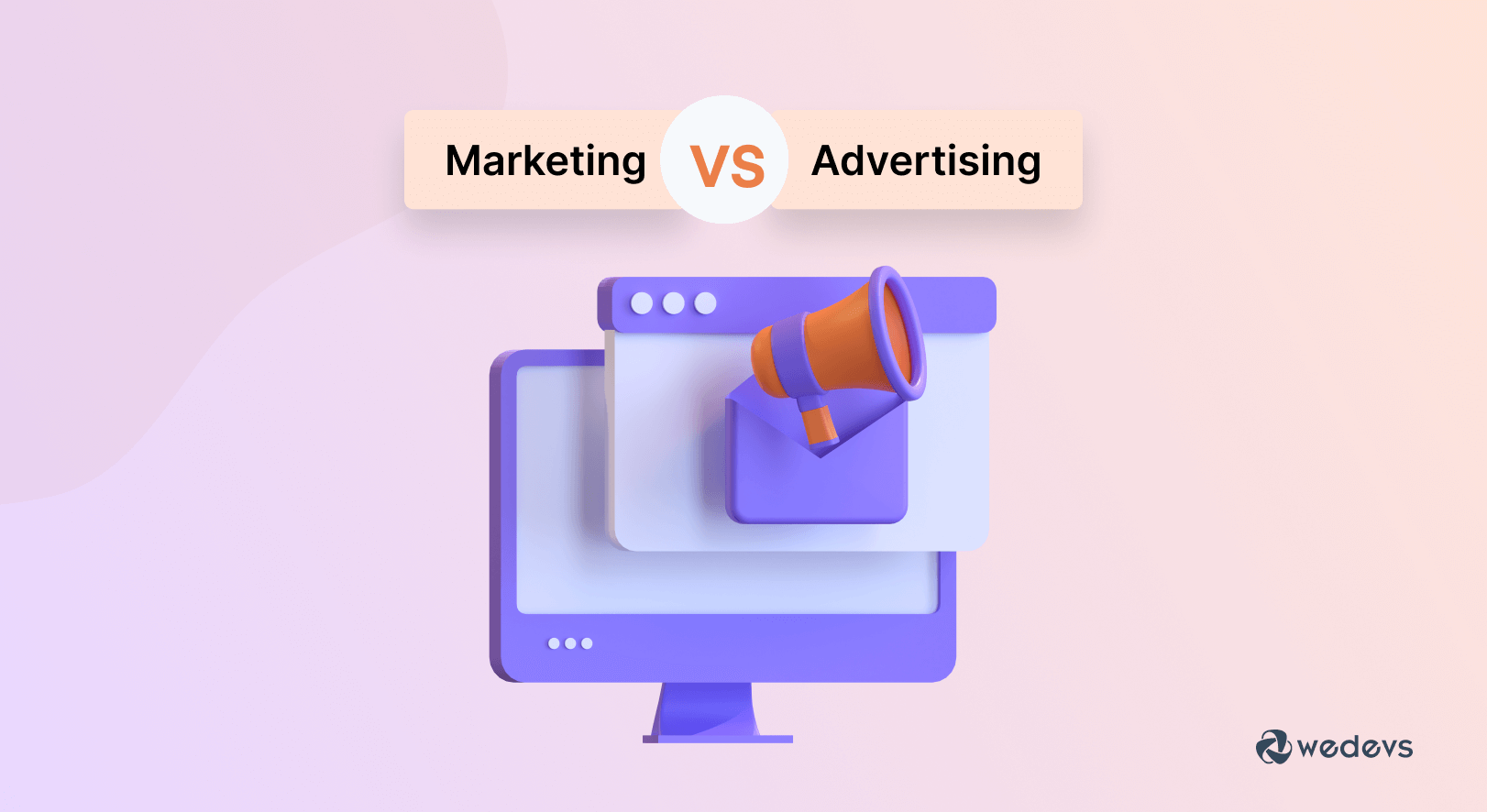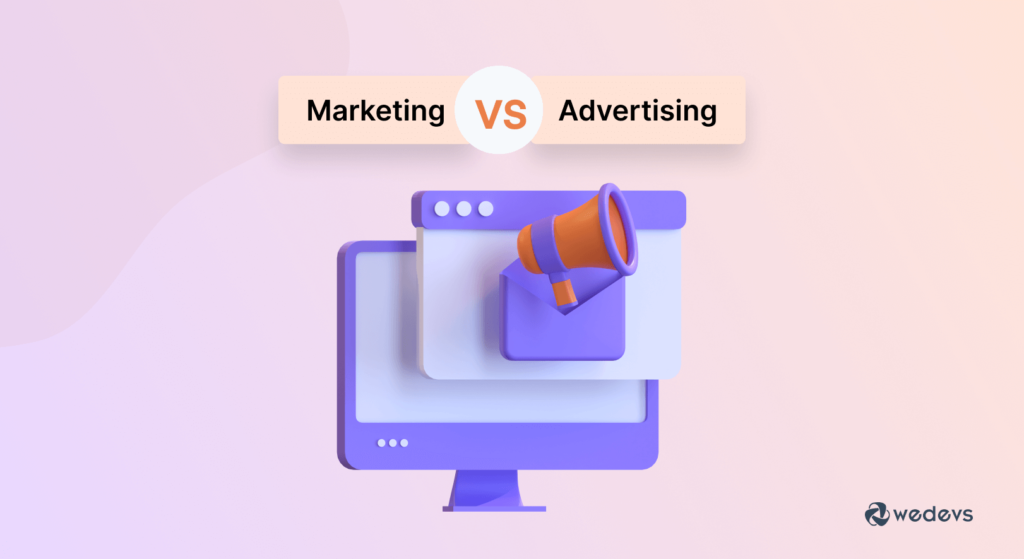
Marketing vs Advertising: Choose the Right Strategy for Your Business
Are you struggling to decide the better approach for promoting your business – Marketing vs advertising? You've come to the right place.
Marketing and advertising are two essential parts of modern businesses. Though these two concepts are related, they have distinct features and functions.
While both aim to promote a product or service, marketing encompasses all the activities involved in identifying and satisfying the needs of customers. On the other hand, advertising is a subset of marketing that focuses on the paid promotion of products and services.
By understanding the key differences between these two concepts, businesses can develop more effective strategies.
Today, we'll explore Marketing vs Advertising – what sets them apart and how they work together for business success!
Let's start from the basics-
What is Marketing?
Marketing is like the engine that drives a business forward. It's all about understanding what people want and finding creative ways to give it to them. Think of it as getting to know your customers, figuring out what they need, and then making sure they know about your products or services.
Imagine you have a lemonade stand. Marketing is not just about making tasty lemonade; it's about knowing who your customers are and how to reach them.
You might ask yourself questions like, Who would enjoy my lemonade the most? Are the kids playing outside or are the adults looking for a refreshing drink? Once you know your target audience, you can figure out how to let them know you exist.
Marketing involves a bunch of different activities. You'll do things like researching your competitors and customers, deciding on a price that's fair for both you and your customers, creating a brand that represents what your lemonade stand is all about, and finding the best places to sell your lemonade.
Types of Marketing
Mainly there are two types of marketing. One is Inbound marketing and the other is outbound marketing.
i) Inbound Marketing
Inbound marketing is like setting up a magnet that attracts people to your business naturally. Instead of interrupting people with advertisements, inbound marketing focuses on creating valuable content and experiences that draw customers in. It's about being helpful, informative, and building relationships.
With inbound marketing, you aim to provide helpful information and resources that your potential customers are interested in. This can be done through blog posts, videos, podcasts, social media content, and more. By offering valuable content, you establish your expertise, gain trust, and become a go-to source for information in your industry.
Once they're engaged, you can nurture those relationships by providing more relevant content, personalized recommendations, and eventually guiding them towards making a purchase or taking another desired action.
ii) Outbound Marketing
Outbound marketing is like going out and actively reaching out to potential customers to make them aware of your business. It's more like a traditional approach, where you initiate contact with people through various channels to grab their attention and generate interest.
Outbound marketing techniques include methods like television and radio commercials, print advertisements, cold calling, direct mail, and email blasts.
The focus is on spreading your message to a wide audience and hoping to capture their attention.
Unlike inbound marketing, which relies on customers coming to you, outbound marketing takes a proactive approach by reaching out to potential customers directly. It aims to create awareness by making your business visible to as many people as possible, even if they may not be actively looking for your product or service at that moment.
What is Advertising?

Advertising is like your friendly neighborhood megaphone. It's all about getting the word out there and making sure people know about your lemonade stand. Think of it as shouting from the rooftops, “Hey, come try our amazing lemonade!“
When it comes to your lemonade stand, advertising is how you spread the message far and wide. It's about creating attention-grabbing messages or visuals that make people stop and take notice. You want to make them curious and excited about what you have to offer.
Advertising is all about grabbing attention, creating interest, and persuading people to come and try your lemonade. It's about making your lemonade stand the talk of the town and building a strong reputation.
Types of Advertising
Like Marketing, there are two major types of advertising. One is Traditional advertising and the other one is Digital advertising.
i) Traditional Advertising
Traditional advertising is like the classic way of getting the word out about your business. It's the type of advertising that has been around for a long time and includes methods that we are all familiar with. Traditional advertising relies on offline channels to reach potential customers.
Examples of traditional advertising include television commercials, radio ads, newspaper or magazine advertisements, billboards along the roads, and even flyers or brochures distributed in physical locations. These methods often involve paying for ad space or airtime to promote your products or services.
ii) Digital Advertising
Digital advertising is like the modern, tech-savvy way of spreading the word about your business. It leverages the power of the internet and various online platforms to reach and engage with potential customers.
Digital advertising includes methods such as display ads on websites, video ads on platforms like YouTube, social media advertisements on platforms like Facebook and Instagram, sponsored search results on search engines like Google, and even influencer collaborations on platforms like TikTok or Instagram.
With digital advertising, you can target specific audiences based on their demographics, interests, or online behaviors. This allows you to show your ads to people who are more likely to be interested in what you offer. It also provides more flexibility in terms of budget control, real-time performance tracking, and the ability to adjust your campaigns on the fly.
Marketing vs Advertising: 5 Key Points You Should Be Aware of As a Marketer

As we have discussed earlier marketing and advertising both are used to promote and sell your products or services. But they are different from each other. You have to take different approaches for different platforms. Let's find out the top 5 parameters to differentiate them:
- Purpose
- Strategy
- Procedure
- Investment
- Measurement
By the end of this article, you’ll be able to clearly understand how these two related terms are truly different.
1. Purpose of Marketing and Advertising
Both marketing and advertising have different purposes. If you can find out your purpose clearly, you can apply the right strategy to achieve that. Let's check when you need marketing and when you need advertising.
Marketing Purpose
- New Products Launching: Marketing can help you to create buzz about your upcoming products and influence your target audience to ensure their pre-orders through early bird discounts.
- Lead Generation: Through inbound marketing like blogging, you can make an email list, and later you can outreach to them to promote your products.
- Customer Acquisition and Retention: Customer acquisition is the process of getting potential customers to buy your products. And retention means nurturing existing customers to continue buying products from you. Creating helpful content to solve your customers' problems and engaging videos on your products help you to acquire new customers and retain existing customers.
- Cross-selling and Upselling Opportunities: You can implement cross-sell complementary products and upsell better products on your checkout page to increase revenue.
Advertising Purpose
- First-Time Buyers' Attention: You can create Google ads to target first-time buyers for your digital products. Or, you can create tv commercials or print ads to attract first-time buyers for your physical products.
- Brand Loyalty Establishment: You can keep informing or reminding customers about the existence of your brand through ads, pop-ups, and sponsored videos. These will help you to make your customers happy and satisfied by increasing brand loyalty.
- Solid Brand Image Formation: Establishing your business as the top-of-mind option among others in the market through advertising.
2. Strategy of Marketing and Advertising
Strategy means how you plan to market or advertise your products. You have to think differently for both platforms to get the fullest out of each platform. Let's check the strategy and technique that you need to use for marketing and advertising.
Marketing Strategy
- Leverage Content Marketing: Human-generated top-notch content can help you the most in marketing your products. Create content to educate your target customers and solve their problems to stay their minds rent-free forever.
- Collaborate with Industry Influencers: Collaborating with influencers and brands whose audiences, products, or services are in line with yours helps you to reach more potential customers.
- Choose Brand Ambassador: Nurture relationships with existing customers so they eventually become brand ambassadors and promote your products on your behalf.
- Launch Affiliate Marketing: Affiliate marketing means people will sell your products through their own channel and you will pay them a commission for each sale. It's another way to market your products.
Advertising Strategy
- Giveaway: Promotional advertising like giveaways, coupons, or temporary price reductions helps you to gain more sales.
- Traditional Advertising: It's another way of advertisement. It includes advertising on print, billboard, tv, or radio.
- Digital Marketing: Digital advertising means running paid ads on Google or social media like FB, Instagram, Twitter, and so on. It also includes video marketing, content syndication, guest posting, etc.
3. Procedure of Marketing and Advertising

The procedure means the whole work process to complete a successful marketing or advertising campaign. Both platforms follow different work procedures. Let's discuss it here!
Marketing Procedure
In the broader sense, marketing is all about sharing your brand with others. It is a way of enhancing potential customers to, in turn, boost revenue.
Marketing involves:
- Research
- Analysis
- Consumer behavior
- Strategy implementation
- Product development
- Strategy planning
- Brand alignment
- Service development
Advertising Procedure
Advertising is a small yet important part of marketing. It usually incorporates:
- Gathering data about customers
- Considering diverse creative strategies
- Designing logos to align with the brand
- Deciding where to place ads
- Track ads performance and keep updating ads copy
4. Investment in Marketing and Advertising
A major difference between marketing and advertising is the investment and figuring out where this investment money will get spent. Now we will discuss investment in marketing and advertising.
Marketing Investment
As advertising is a part of marketing, so, general marketing expenses include the advertising budget along with a broader range of marketing-related expenses.
The broader range of marketing-related expenses includes marketing software and tools, customer research processes, channel specialists, and website development. So, here is a list of where you should spend your marketing budget:
- Focus on human resources
- Invest in data like website traffic, customer behavior, and buyer persona
- Upskill team members
- Spend strategically on social media and SEO
- Explore sponsorship opportunities
- Market to existing customers
Advertising Investment
Advertising is notoriously expensive. A study by projections cite on advertising budget shows that,
US companies are projected to spend more than $65 billion on social media advertising alone in 2022.
This funding mainly goes toward two segments: creative and distribution. Creative investments may include graphic designers, copywriters, or art directors. Distribution includes activities like securing ad platforms (TV, radio spots, and physical space) or outsourcing to advertising agencies.
5. Measurement of Marketing and Advertising

Marketing and advertising both measure the number of people they reach. But in different ways. Marketing counts different metrics and advertising counts different metrics. Let's find out how they measure success.
Marketing Measurement
Marketing counts the number of people who are reached and then make at least one purchase. One way to think about it is that marketing uses statistical measurements to help a company determine whether or not its ads are working.
For example, if a marketing campaign has 5,000 impressions but only 100 conversions, this means that out of all those people who have seen the ad, only 2 percent were interested in buying your product.
So, marketing will give you two important data:
- Conversion rates and
- Advertisement cost per customer
Advertising Measurement
Advertising is measured by impressions or how many people see the ad. It will just tell us how many people saw the ad, without taking into account if they were actually interested in our product or not.
So when we are measuring the effectiveness between marketing and advertising, marketing's measurement goes further than advertising by calculating how much revenue is generated from an ad campaign.
Marketing vs Advertisement – A Quick Comparison
By coming this far, you may have already figured out the difference between marketing and advertisement. Then again, we have created this comparison table so that you can get all the crucial information in one place in no time.
| Marketing | Advertising | |
|---|---|---|
| Definition | Marketing is the process of identifying customer needs and determining how best to meet those needs. | Advertising is the exercise of promoting a company and its products or services through paid channels. |
| Purpose | Product launching, Lead generation, customer acquisition, retention | First-time buyer's attention, brand image, and loyalty establishment |
| Strategy | Content marketing, affiliate marketing, collaboration with industry influencers | Giveaway, traditional marketing, digital marketing |
| Procedure | Research, analysis, consumer behavior, strategy implementation, product development, and strategy planning | Gathering data about customers, considering diverse creative strategies, deciding where to place ads |
| Investment | Invest in data like website traffic, customer behavior, and buyer persona. Upskill team members, and spend strategically on social media and SEO | Invest in graphic designers, copywriters, or art directors. Also, keep the budget for securing ad platforms (TV, radio spots, and physical space) or outsourcing to advertising agencies. |
| Measurement | Measures conversion rates and advertisement cost per customer | Measures impressions or how many people see the ad |
FAQs on Marketing vs Advertising
No, advertising is a subset of marketing. Marketing involves a broader range of activities such as market research, product development, pricing, distribution, branding, customer relationship management, and more. Advertising specifically focuses on creating and delivering persuasive messages to promote products or services.
Yes, marketing can exist without advertising. Though advertising is one of the most effective marketing tools, there are other components for marketing as well. Advertising is just one way to communicate and promote products or services.
Both marketing and advertising are essential for the success of a business, but their importance may vary depending on the context. Marketing provides the overall strategic framework for achieving business goals, while advertising plays a significant role in creating awareness, generating interest, and persuading customers. The importance of each may differ based on factors such as industry, target audience, product/service type, and marketing objectives.
While advertising can have some impact without a comprehensive marketing plan, its effectiveness is typically enhanced when it is part of a well-developed marketing strategy. A marketing plan helps identify target audiences, understand customer needs, set clear objectives, and coordinate various marketing activities, including advertising.
Choose the Right Media for The Right Purpose
Being able to choose the right media (Advertising or Marketing) for the right purpose can save you time, money, and energy. On top of that, it will help you to reach your target revenue with the right strategy. So, first, clear your confusion on Marketing vs Advertising, and then plan for your strategy.
Here is a quick recap on marketing vs Advertising:
- Advertising is a subset of marketing.
- While advertising is marketing, marketing is not advertising.
- Marketing involves many other types, including often paid channels.
- The goals between marketing and advertising are similar, but the methods differ.
- Marketing concentrates on product, price, promotion, place, people, and process.
- Advertising concentrates on the promotion of the product.
Marketing is the method of building brand awareness and messaging. Advertising is a subset of marketing but an essential one. Therefore, the most effective marketing strategies will incorporate advertising, as well as other types.
That's all!
If you have any further confusion, don't be hesitated to ask us in the comment box below. We would love to answer your queries.